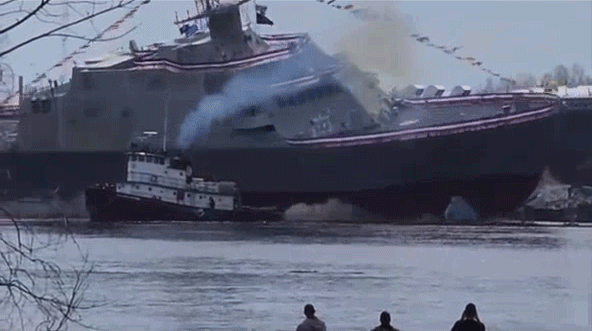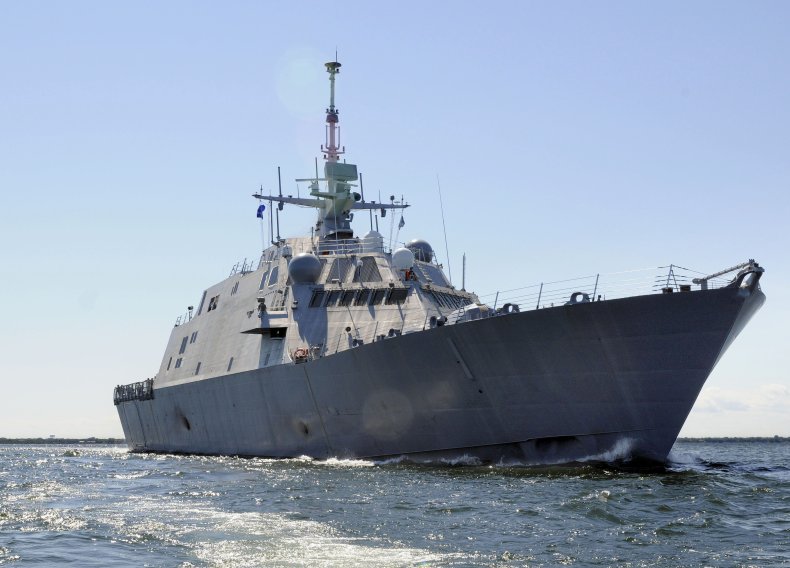風蕭蕭_Frank
以文會友美國新軍艦剛剛下水就被撞毀,打臉了誰?
眾所周知,美國正在經曆本世紀最嚴重的經濟危機,美債到期不能兌付這在美國200多年曆史上,還是空前的,與此同時,美軍各方麵的軍事失敗也在摧毀“三位一體”帝國架構的最後一根支柱……
Launch of brand new U.S. warship goes away

從蘇丹撤僑就能看出,美國海軍不敢行動,白宮負責人告訴各大媒體“我們隻能先撤走大使館官員,其他的數以萬計美國人隻能自己尋求避難…”再加上之前在阿富汗、敘利亞、索馬裏一帶的拉胯表現,美軍,讓世界各國發現,它其實非常虛弱。
所以,五角大樓也很著急,為了“盡快彌補”美國海軍戰力的不足,它要求美國軍工體係“盡快”讓新的軍艦下水,以應對美軍裝備普遍老化和可用艦艇總規模不足的窘境。好了,問題來了,越是著急,事故就會越多……

4月下旬,據美國Newsweek放出的視頻,一艘新的美國海軍軍艦在一次“戲劇性”的下水過程中,與一艘美軍的拖船相撞,然後翻進了海裏。
美國海軍曾在周五證實,將“命名並發出”最新型的海軍自由變種LCS,即瀕海戰鬥艦,以應對“即將開戰”的需求。很快,海軍公布了“大躍進式快速下水”的艦艇名稱:即美國克利夫蘭號(LCS 31)。該船於當地時間周六上午10點在威斯康星州的Fincantieri Marinette海軍造船廠下水。據美國海軍稱,這是威斯康星州軍事碼頭在升船係統徹底就位之前,最後一次預定的側翼下水儀式。
在歡呼聲中,船隻慢慢啟航,但美國海軍克利夫蘭號立即向一側傾斜,並在拖船上掀起巨浪。軍方調查稱“是繩子太短、拖船太少”導致……後來又說,可能極端天氣也要承擔責任。但從視頻的細節看,撞擊現場根本沒有大風,甚至沒有浪……打臉的是,曾經,美國海軍是準備要上兩艘以上拖船來讓龐大的軍艦下海,但後來又因為“準備不足”,隻上了一艘拖船,而且,神奇的是,拖船似乎真的“因為繩子太短”是從側麵在拖拽軍艦……
從軍方含糊其辭的聲明來看,這次“下水儀式”是徹底的失敗。更加失敗的是,軍方的調查報告不敢也不能查出真正的事故原因。將責任推給拖船太少、駕駛員“不專業”和“繩子太短”,都是非常不負責任的操作。
有趣的是,海軍部長卡洛斯·德爾·托羅在下水活動前一天的新聞稿中還表示:此次下水儀式“將是它加入我們的艦隊、在公海遠航、繼續保衛我們的國家和快速投入戰鬥又近了一步,代表著我們的美國海軍與克利夫蘭市的緊密聯係”。部長並沒有胡說,因為美國海軍將LCS級艦艇描述為“快速、載人最佳、執行遠洋(作戰)任務量身定製的水麵戰鬥艦艇”,能夠在近海和公海和“敵人”戰鬥。
海軍部還解釋說,LCS級艦艇有兩種變體,即自由號和獨立號,主要區別在於單體和多體係統設計。但由於這是美軍大躍進式“快速建造”以及“快速投入戰鬥”的艦艇,五角大樓專家們對這些作戰單位的持續使用存在分歧,這些“新生代”軍艦一直受到“可靠性問題”的困擾,這意味著,它們很可能不是“一個巨大的成功案例”。
沙利文昨天的演說確實很“誠懇”,花街金融界的操作,真的蛀空了美國的製造業,這其中甚至包括和軍事有關的重工業。以至於拜登想要加緊備戰,下邊都執行不好。當然,海軍部的調查報告也可以寫得更華麗一些,比如,我們需要更多經費以應對可能的事故和災難,這樣就能再添一筆收入了……數十年來,美國的天價軍費不就是這樣被吃掉的麽?
Launch of Brand New U.S. Warship Goes Awry
Anew U.S. Navy warship appeared to collide with a tugboat during a "dramatic" launch of the vessel.
The U.S. Navy said on Friday that it would "christen and launch" the latest Freedom-variant LCS, or Littoral Combat Ship, which would be known as the U.S.S. Cleveland (LCS 31). The ship launched at 10 a.m. local time on Saturday at the Fincantieri Marinette Marine shipyard in Wisconsin. It was the last scheduled side launch of a ship at the Wisconsin shipyard before a ship lift system is put in place, according to the Navy.
In footage purportedly showing the event, the new LCS appears to collide with the tugboat that aided the launch. Amid cheers, the boats slowly take off, only for the U.S.S. Cleveland to immediately tilt to the side and send a wave crashing over the tugboat. It's unclear if the warship slammed into the tugboat, or if it was sent backward because of the force of the wave.
 The U.S.S. Freedom (LCS 1) is shown during day one of the ship's builders' trials on July 28, 2008. On April 14, the U.S. Navy said it would "christen and launch" the latest Freedom-variant LCS, or Littoral Combat Ship, which would be known as the U.S.S. Cleveland (LCS 31).LOCKHEED MARTIN/GETTY IMAGES
The U.S.S. Freedom (LCS 1) is shown during day one of the ship's builders' trials on July 28, 2008. On April 14, the U.S. Navy said it would "christen and launch" the latest Freedom-variant LCS, or Littoral Combat Ship, which would be known as the U.S.S. Cleveland (LCS 31).LOCKHEED MARTIN/GETTY IMAGES
"No personnel injuries occurred, but there was limited damage to LCS 31," the spokesperson added.
"The damaged area is well above the waterline and no flooding occurred," but an "assessment was completed and permanent repairs are being planned."
Root cause of the incident is currently under investigation by the Navy and shipbuilder," they continued.
Mark Grove, a senior lecturer at the University of Lincoln's Maritime Studies Center at the Britannia Royal Naval College Dartmouth, told Newsweek that the tugboat is there to "pull" the ship into the water, working with gravity to side-launch the new vessel in what is "the most dramatic" and an "old-fashioned" form of launching.
It is typically used when there is not sufficient water to launch the vessel stern-first down a slipway, Grove said, and vessels will usually need to be designed with this specific launching technique in mind.
The ship, which is the fourth to be named after the Ohio city of Cleveland, is the 16th—and final—Freedom-class LCS.
The launch "will be another step closer to joining our fleet, sailing the open seas, continuing to defend our nation, and representing the strong connection our Navy has with the city of Cleveland," Carlos Del Toro, Secretary of the Navy, said in a press release ahead of Saturday's event.
LCS-class vessels are described by the U.S. Navy as "fast, optimally-manned, mission-tailored surface combatants," able to navigate near-shore waters as well as the open ocean. There are two variants of LCS class ships, known as Freedom and Independence, with the key difference being the monohull and multihull designs, Grove said.
They are designed to be relatively small, fast and inexpensive vessels, with a small number of crews operating the highly maneuverable ship. Experts are split on the continued usefulness of the vessels, which have been plagued by "reliability issues," meaning they have not been "a huge success story," Grove said.




